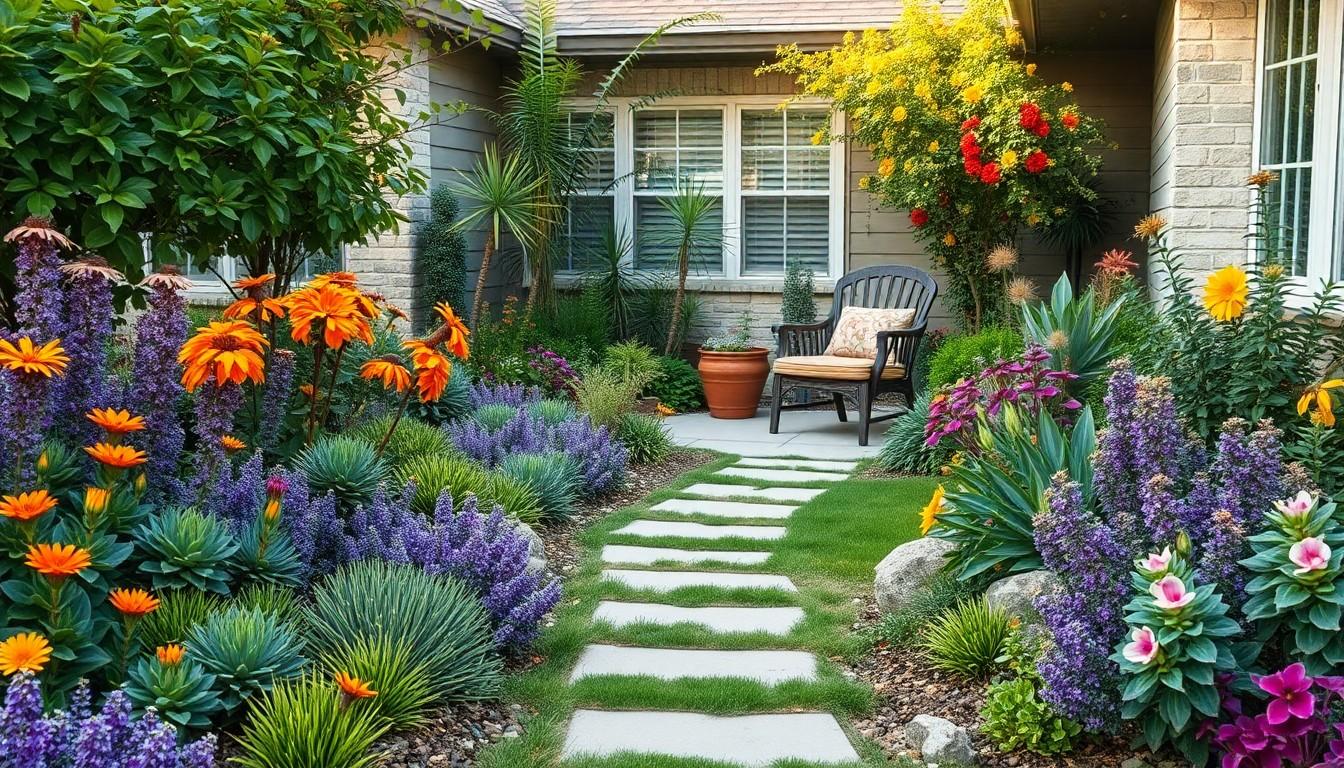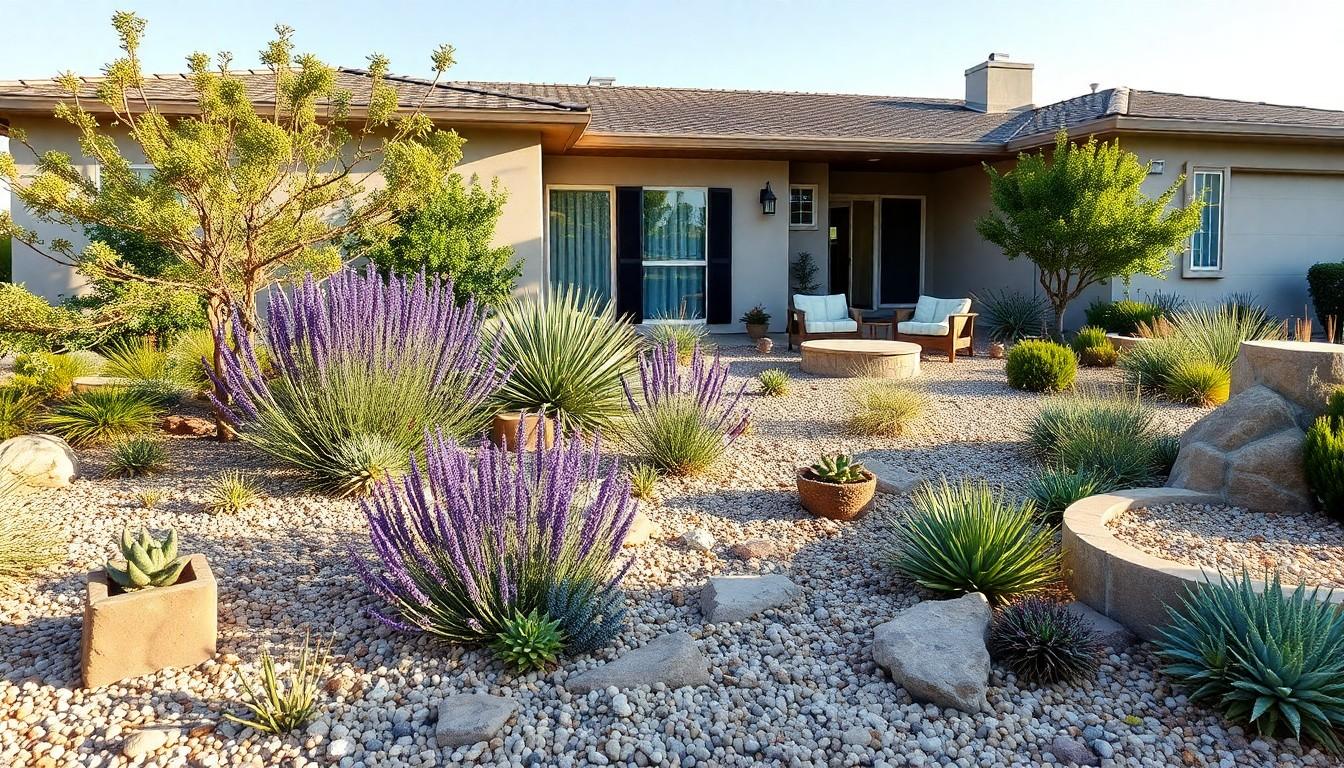In a world where water is becoming scarcer than a unicorn at a petting zoo, modern front yard drought-tolerant landscaping is not just a trend—it’s a necessity. Gone are the days of lush green lawns that guzzle gallons of water. Instead, homeowners are embracing innovative designs that are both eco-friendly and stylish. Who knew saving the planet could look so good?
Imagine transforming that thirsty patch of grass into a vibrant oasis filled with native plants and smart irrigation systems. Not only will it make your neighbors green with envy, but it’ll also give you a reason to brag about your sustainable choices at the next barbecue. Let’s dive into the world of drought-tolerant landscaping and discover how to create a front yard that’s as practical as it is pretty.
Overview of Modern Front Yard Drought Tolerant Landscaping
Modern front yard drought tolerant landscaping focuses on reducing water usage while enhancing curb appeal. Native plants represent a key element, as they thrive in local climates and require minimal maintenance. Adapted to their environment, these plants often resist pests and require less irrigation compared to non-native varieties.
Incorporating hardscape elements like gravel and stone also benefits drought tolerant design. These materials reduce the need for water and provide a stylish contrast to greenery. Utilizing permeable pavers allows rainwater absorption, mitigating runoff and promoting healthier soil.
Smart irrigation systems play a crucial role in conserving water. These systems can automatically adjust watering schedules based on weather conditions, ensuring plants receive adequate hydration without waste. Drip irrigation efficiently delivers water directly to plant roots, minimizing evaporation and runoff.
Choosing the right plant combinations further enhances water conservation. Succulents, ornamental grasses, and drought-resistant perennials can create a vibrant landscape while minimizing water needs. Grouping plants with similar water requirements simplifies maintenance and promotes healthier growth.
A well-planned layout enhances both aesthetics and functionality. Incorporating diverse textures and colors creates visual interest. Pathways, seating areas, and focal points invite outdoor activities while minimizing water requirements.
The combination of these elements fosters a sustainable environment and reflects a homeowner’s commitment to eco-friendly practices. As drought conditions become more prevalent, adopting these landscaping strategies offers a practical solution for maintaining beauty and sustainability.
Benefits of Drought Tolerant Landscaping

Drought-tolerant landscaping offers numerous advantages that benefit both homeowners and the environment.
Water Conservation
Water conservation ranks among the primary benefits of drought-tolerant landscaping. This approach significantly reduces water usage, with native plants requiring minimal irrigation once established. It conserves water by leveraging natural rainfall rather than depending on frequent sprinkling. These water-efficient designs lower utility bills while promoting sustainable practices. Adopting smart irrigation systems further enhances efficiency, as they automatically adjust water schedules based on weather conditions. Research shows that homeowners can cut outdoor water use by up to 50% through these landscaping techniques.
Environmental Impact
The environmental impact of drought-tolerant landscaping is substantial. It fosters biodiversity by utilizing native plant species that support local wildlife. Healthy ecosystems thrive when birds, butterflies, and beneficial insects find habitats within these landscapes. Water quality also improves, as reduced runoff minimizes pollution draining into local waterways. Implementing permeable hardscape materials aids in filtering rainwater, supporting groundwater recharge. Landscape designs prioritizing native flora lead to less fertilizer and pesticide use, diminishing chemical runoff. Communities gain resilience to climate change, establishing greener, more sustainable living spaces.
Design Elements
Modern front yard drought-tolerant landscaping incorporates unique design elements that enhance aesthetic appeal while conserving water. Two crucial aspects are plant selection and hardscaping features.
Plant Selection
Choosing the right plants ensures both beauty and sustainability. Native plants, such as lavender and salvia, thrive in local climates, reducing the need for irrigation. Succulents, with their water-retaining abilities, enhance the landscape while requiring minimal upkeep. Drought-resistant perennials, including yarrow and black-eyed Susan, provide vibrant colors year-round. Implementing various textures in plant selection, such as ornamental grasses alongside colorful blooming species, creates visual interest and promotes biodiversity.
Hardscaping Features
Incorporating hardscape elements adds structure to the landscape. Gravel pathways can define areas while allowing rainwater to permeate the soil. Stone accents, including retaining walls and decorative boulders, contribute to a modern aesthetic and help with soil retention. Utilizing permeable paving materials not only supports groundwater recharge but also minimizes erosion. Efficiently designed seating areas, made from sustainable materials, encourage outdoor use while enhancing the overall appeal of the yard.
Maintenance Tips for Drought Tolerant Yards
Maintaining a drought-tolerant yard involves specific strategies tailored to conserve water and promote plant health while enhancing beauty.
Watering Strategies
Focus on deep watering to establish strong root systems. Early morning is the best time to water, reducing evaporation. Use drip irrigation systems to target plant roots efficiently, minimizing water waste. Group plants with similar watering needs together; this practice helps in providing the right amounts consistently. Monitor soil moisture before watering; established plants may not need frequent watering. Mulch retains soil moisture, reduces temperature fluctuations, and suppresses weeds effectively. Collect rainwater using barrels; this sustainable approach enhances water conservation while fulfilling irrigation needs.
Seasonal Care
Evaluate plant health each season; timely observations foster early intervention. In spring, apply fertilizer to support new growth, using organic options for sustainability. Summer requires checking for pests and diseases; immediate action protects plant vitality. During fall, prune back spent foliage and remove dead plants to prepare for winter. Incorporate compost into the soil before winter; this practice boosts soil health and fertility. Assess hardscape features, fixing any erosion or drainage issues promptly. Engage in seasonal replanting; choosing appropriate plants supports year-round color and vitality in the landscape.
Conclusion
Embracing modern front yard drought-tolerant landscaping is a powerful way to address water scarcity while enhancing the beauty of outdoor spaces. By prioritizing native plants and smart irrigation systems, homeowners can create stunning landscapes that thrive with minimal water use.
These eco-friendly designs not only contribute to lower utility bills but also support local ecosystems and promote biodiversity. With thoughtful planning and maintenance, a drought-tolerant front yard can become a vibrant and sustainable centerpiece that reflects a commitment to environmental stewardship.
Investing in such landscaping solutions is not just a trend; it’s a responsible choice for a sustainable future.

